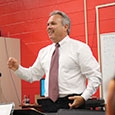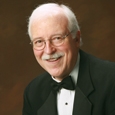Stephen Shewan is director of bands at Williamsville East High School in East Amherst, New York, as well as a prolific composer who has written for band, orchestra, choir, and numerous chamber ensembles. He brings his passion for composing into his classroom by finding creative ways to teach aural skills and digging deep into the music to show students interesting compositional techniques. All of his students are required to compose one piece per year as part of a collaboration with the school’s English, art, and dance departments. Shewan’s awards for composing and teaching include the 2000 Buffalo Philharmonic Orchestra/Erie County Council of Music Coordinators Award for Excellence in Music and the 2004 New York State Band Director Association’s Richard H. Snook Outstanding Band Director Award. He also won the 2011 Robert H. Campbell Endowed Choral Composition Prize at the annual Choral Composition Festival at the Ithaca College School of Music and the 2016 Tampa Bay Master Chorale Christmas Carol Contest. Recent awards include the 2018 Edwin Fissinger Choral Composition Award and the 2018 Vocal Essence Welcome Christmas Carol Contest sponsored by the American Composer’s Forum.
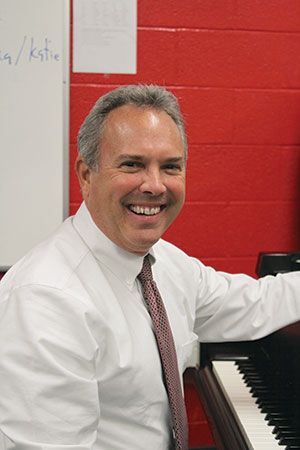
photo by Amy Vohwinkel
It is an exercise called the Summer Ear Tune. At the end of the school year, students get an audio recording of their part from a band piece. I don’t share the name of the piece, because students will find it online. The assignment is for students to learn their part by ear. On the first day of school, we play it together. It won’t be perfect, because some students heard something wrong or are not ready to play with the other parts, but it is such an illuminating moment. In addition to the aural skills gained from this assignment, it isn’t something they can fake. The students who come in with their part learned have been practicing over the summer. Also, it makes an amazing first-day experience for everyone.
I get a workout as well because I memorize the entire score to the point that I can sing every line and every part. It wouldn’t be right for me to stand up there with a score in front of me after asking students to memorize their parts. I will mess it up in rehearsal, and that’s okay. We have an environment where mistakes are allowed.
Some of these pieces we have repeated because it is difficult to find a composition that works well. We’ve done Grainger’s Ye Banks and Braes O’ Bonnie Doon and Irish Tune from County Derry and the Bruce Houseknecht arrangement of Chesnokov’s Salvation is Created. I arranged O filii et filiae by Volckmar Leisring one year. Believe it or not, one of the best pieces for this is the Shostakovitch Galop, because it is a modified rondo form. Students always love that one as an ear tune.
When we play the Shostakovich, the percussion section and I will be in the middle of the auditorium, and the wind players line both of the aisles. We cover the windows and turn off the lights so it is pitch black, and the I conduct the summer ear tune with a light-up baton, which is the only thing the audience can see. The audience loves it. The students never see the music, unless they have written their parts out. Some of them, especially the younger students, do that. Their ears aren’t developed enough, so they write it out, and then learn it that way. They still have to write it out by ear, so I don’t have a problem with it.
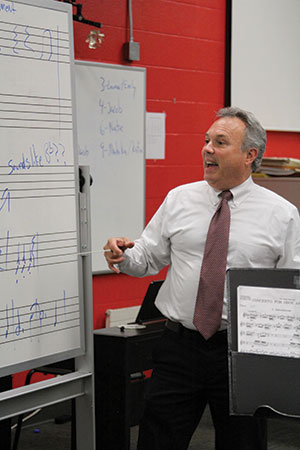
What are the building blocks of a successful rehearsal?
A rehearsal should cover both performance and comprehension. Students should play with characteristic tone and proper style, and they should also be learning about melodic and rhythmic components, musical structure, harmonic progression, tonality, key centers, and modulations, all of which show how a piece moves from point to point. Make time for aural skills because these help students immensely.
For us, a typical rehearsal will depend on the time of year and the current unit. Early in the year we work on the twelve major and minor scales. That said, so much band music, especially middle school band music, is in dorian or mixolydian tonality. If a piece is in F mixolydian, do not warm up on an F major scale beforehand. To do so would be to miss a nice opportunity to show students what is in that day’s music and teach modes.
We frequently sing in warmups. There is a unit on the seven diatonic triads in major and minor tonalities, during which I have students sing triads in solfege. I also have students learn themes from that day’s music by singing them and having students sing back to me. If you sing a melody with the exact style and articulation you want, that is how the students learn it. Once the students can sing a melody the way I want it, then everyone learns to play it that way, regardless of whether they have the melody in their part. That’s how we develop aural skills, and when we’re done, everyone knows the nuances I want. Some might argue that we’re teaching by rote, but teaching by rote is putting the music in front of them and then singing it to them, so they don’t have to figure out the rhythm. Our students still read music.
We also sing and play chord progressions from our repertoire. If students are going to write music, they have to hear harmonic movement, not just melodic movement. We will isolate and sing interesting chords. This also works well in jazz ensembles. Everyone sings, and then we play the chord again and it’s in tune. It’s not just an aural skill we’re developing. It’s an intonation practice.
I like to have the kids finger notes while singing, so they make that connection to their instruments. Sometimes I teach a theme by singing it, and then give students 60 seconds to figure it out on their instruments. It is a cacophony of sounds, but everyone is engaged. At the end of the 60 seconds we play it together and see how we did. If there is a passage or certain interval that everyone struggles with, I isolate that. We teach intervals, so if the interval in question is a major sixth, they would know that and be able to play it.
Warmup time is for preparing the areas of the repertoire that I want to work that day. As we warm up, I will say to students that I’m going somewhere with the singing and ask them to trust me. Then we go to the piece and they say, oh I get it, that’s the progression here, and now I understand this piece better. Here’s a quote that we put into a NYSSMA project based on our program that was filmed:
“Playing themes by ear is a regular component of our daily rehearsals. It is frequently done during the warm up time. This allows all students to perform themes while developing aural skills as well as performing musically with characteristic tone qualities. Analysis of the piece helps the student understand and organize the music. This ultimately is a rehearsal shortcut resulting in less rehearsal time spent on drills.”
We might focus on structure one day and forms within the structure on another. This can be split into small structures, like phraseology, or we might be looking at large structure. Here are some of the questions I ask:
• What is the structure of this piece?
• Is this section different or the same?
• What from the first section might be being used here?
• What’s the same?
• What’s different?
• Is it ABA?
• Is it a rondo?
• Is it a sonata?
• Does the piece have a melody or is a color piece?
• What chords are under these notes that are so cool to listen to?
• Is there a consistent use of rhythmic or melodic motives?
We also look at themes and think about the form of the phrase. We call the first phrase A, and then look at the next phrase. If it is identical, we call it A, but if it is different, we call it B. The next phrase might be A but with something different. We talk about it, and then most students want to call it A, but some of the mathematicians like to call it A prime. I prefer A prime myself, but I don’t force it on them. We do all of this work by ear. It’s more than just developing aural skills, it makes the band sound better.
Music is rarely as complex as one might think. If you look at every component you can break it down so it makes more sense. Clifton Williams’s Symphonic Dance No.3 – Fiesta has a melody with a harmony and an ostinato, and that’s about it. When we break it down like that, it seems more approachable to students. Moth by Viet Cuong has noodling passages. If you figure out what scales are being used in these runs – they are usually modal – and isolate chords from the rhythms underneath, an aspiring composer can create a similar soundscape.
At the end we try to wrap it all up and play the full section that we learned that day or sections, because sometimes we are working on more than one piece.
In addition, sometimes you just need to rehearse. As the day of a performance approaches, there might not be time for an extended warmup or meaningful conversations about form. The compositional elements should have already been discussed. When I encounter naysayers who say they don’t have time to teach structure or compositional style, I understand that feeling. However, I encourage them to try teaching comprehensively on one piece and see whether the rehearsal time on that piece gets shorter. When students understand structure, the piece becomes smaller and easier to decipher in some ways. Suddenly it is not a 250-measure piece, it is an ABA piece, and within the context of A it is an AABA. It is much easier to think about music in such terms. I find that if I can convince people to try it a little bit, they get more excited about music themselves, which inspires their students.
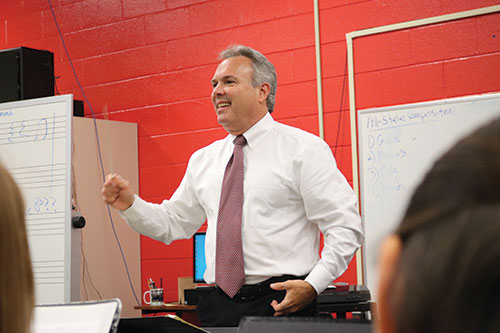
What are your favorite rehearsal tricks?
One of my favorite rehearsal techniques for overcoming a difficult passage is to have the students with that passage turn their stands around so they cannot see their music. Then, I sing the passage slowly to the whole band. All the students then have to play the passage to the best of their ability. This engages those who are not rehearsing at the moment, leaving no time for discipline problems. It also has students learning the piece aurally as well as from reading the music and gives a deeper meaning to the passage.
Sometimes we interchange the parts, perhaps by having brass players learn a run that was originally in the woodwind parts. It gives us a chance to talk about color and why a composer may have chosen woodwinds to play the passage. Classroom discussions about orchestration are always interesting.
I’ve heard that your students are excellent sightreaders. How do you get them there?
We sing a lot of solfege. That helps with the tonal side of things. I’ll have the students solfege themes back to me. I use movable do, but also use a la-based minor and a re-based dorian.
We also use PracticeSightReading.com, a free website that has five duple-meter rhythm units and four triple-meter rhythm units. We assign these to students who make the wind ensemble, which is our top group, for the first time. Students use the Gordon syllables and must get a perfect score on two sets to advance to the next unit and must complete all of the units by the end of the first ten weeks, at which point then can read almost any rhythm we throw at them.
Every student in your band program composes one piece per academic year. What are the parameters of this assignment?
My passion is composition, so I enjoy sharing that. It is important that directors bring the things that they care about the most into their classroom, because that is what excites them and will excite the students. This has been one of the problems with getting composition implemented into more programs – it is not the director’s passion. Because it is my passion, it impacts rehearsals and lesson plans. We look at the literature we are playing, and we know the form and the special features that stand out, such as an unusual chord or progression. Much of what I plan includes a heavier emphasis on analysis. I like to lead students to get inside a composer’s mind to figure out why they used certain composition techniques. Also, this is a good lead-in to getting students to be creative.
Samuel Adler was my composition teacher. Each week I would bring something in, and he would say something like, “Steve, that sounds a little like the Barber First Essay for Orchestra. Go listen to that.” It seemed like he knew every piece ever written and always sent me to the right piece. The point was not for me to change my work but to use the piece he suggested as a role model. That was how I was taught to compose, and it is what I try to do in rehearsal. Not every piece grabs every student, but it affects them when they start composing.
Our composition writing program runs from January to the first week of March. During that time, we have our district-wide Poetry Music Celebration. Students at seven elementary, four middle, and three high schools write poems, and students can access all of the poems online. Band students choose a poem that inspires them to write some kind of music.
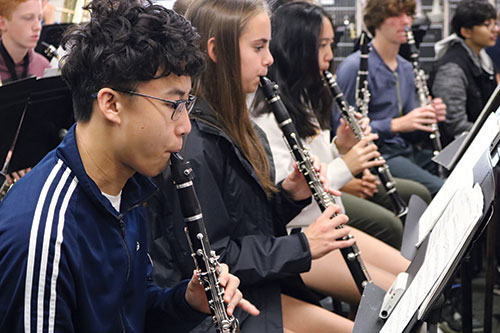
photo by Cody J. Romanos
After a few years, our orchestra director, Wayne Moose, suggested getting the art teachers involved as well. Now, a student in any grade from kindergarten through high school will read their poem. After that, a musical selection based on the poem is either sung or performed. If there is accompanying artwork, we project it up on a large screen while the music is playing. Sometimes, the piece also has a dance component, so it can turn into a multimedia experience. There is always a poem, and then there might be music, dance, art, or any combination of these. One of the greatest things is seeing a six-year-old child read a silly poem and then having a jazz band with a singer tear up a hot piece on that poem while the kid’s eyes are like saucers.
What types of selections do students compose?
My students lean toward instrumental music, especially chamber pieces, but I encourage them to write vocal music. When dealing with text, there is no deeper marriage of the text and music than the text with the voice. We get all varieties of solo and ensemble works. Unusual works from last year include a piece for tenor voice and tuba and a piece for a 30-note music box.
I have learned to ask students what ensemble they are planning to write for. Sometimes a large number of students lean a certain way, such as wanting to write a trumpet duet. I help students decide whether their piece might work best in another genre.
In the first week of March we assemble a committee of people across the district to choose 15-17 pieces to perform on a concert. Some pieces that don’t get performed on that program are added to other programs, as do compositions students write for fun earlier in the year. One weakness of our program is that we have too many pieces that go unperformed. If we have the right instrumentation, we play through some in rehearsal. Part of the problem is rehearsing everything. Some of the pieces are challenging, and we just don’t have the time to prepare more than 100 pieces. We used to have a composers’ forum at night where we played 40-50 other pieces, but it became cumbersome.
What are common mistakes student composers make?
I could write an entire article on this question. One common error is overuse of whole notes in accompanying passages. Sometimes composers give such lines motion by adding a quarter or half note as fits. When students come in with 16 whole notes in a row in one of their compositions, I ask them whether they would like to play that part, and show them ways to add melodic interest to the line.
What is the most challenging aspect of your position?
As a secondary teacher or a high school director, the most difficult thing to do is engage with remedial students who have lost their confidence and love for their instrument. It happens everywhere and might be accompanied by parents who refuse to let the child quit music. Music is a bad experience for these students, and trying to turn that around has probably been the most challenging aspect of my position. You have to get them to believe in themselves and reignite that spark. Even getting them to believe enough to sit with good posture and engage in rehearsals is difficult, let alone inspiring them to practice.
The other difficulty is that schools focus way too much on tests and academic materials and not enough on arts and the whole student anymore. I feel that education has lost its focus putting kids first. We’ve forgotten that we’re working with children, not machines. Let kids be kids and learn and grow as human beings. Give them the opportunity to immerse themselves in the arts. They’ll be fine.
What advice would you offer students as they prepare for a career in instrumental music education?
Treat your students with dignity and love while maintaining the highest possible standard. Keep the standard high, but never use it to hurt or insult anyone. The students need to learn to represent themselves well rather than concentrating on beating others. If they learn to represent themselves well, they will go far in life.
Work to develop students’ all-around musicianship instead of only performance skills. Give them the ability to create after they have left your classroom.
Try not to schedule your year the same way every year. That routine where everything happens at the same time of year is easy to fall into but leads to burnout. Do something unique each year. Teachers need new challenges and opportunities to stay motivated.
Look back at what you loved about your education, then share that with your students. Do the things for your students that meant something to you. Also, consider what you never learned to do but wish you had, and make sure that is part of what you give your students.
What could university undergraduates do to make sure they are teaching in the ways that you suggest?
I would like to see music ed majors have a required arranging/composition course. It doesn’t have to be heavy duty; someone wanting to teach elementary school could arrange simple folk songs. If teachers are confident in their own skills as composers and arrangers, they will feel confident teaching students to develop their creative skills. Teachers don’t have to be great composers to instill confidence in their students to become creative musicians.
Music education majors should learn how to teach creativity. They should experiment with composition and improvisation. I’m not talking about jazz, but any kind of improvisation. You could go way out like Murray Schafer stuff, or Morton Subotnick, or simply improvise over a chord progression. To be creative music teachers, we have to know how to create.
What did you learn on the job that you didn’t learn in a classroom?
Music education is about students first and music second. People don’t remember what you taught them but rather how they felt. If they come to your music program and it feels good, they are going to learn a lot. If they look back and remember that music meant so much to them, they will support music in the future. They are going to go to concerts, their children are going to play music, and they will be lifelong learners. I would love for all of my students to still be playing and composing when they are 40, and while only a few of them will, good experiences in school will ensure that they remain interested in the arts.
